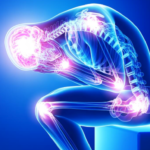Back pain relief isn’t always about quick fixes; it often comes from consistent daily habits that support long-term health. Simple lifestyle changes can make a lasting difference in reducing discomfort. By focusing on small, intentional actions each day, individuals can build a strong foundation for back pain relief. Here are some daily habits to incorporate for relieving back pain:
Prioritize Movement and Posture
Regular movement is one of the helpful approaches for back pain relief. Your spine needs consistent motion to maintain flexibility and strength. Walking for some minutes daily can improve blood flow to your back muscles and reduce stiffness. Proper posture plays a key role in preventing back pain from worsening. When sitting, keep your feet flat on the floor and your back against the chair. Your computer screen should be at eye level to avoid hunching forward. When standing, distribute your weight evenly on both feet and keep your shoulders back.
Stretching helps maintain flexibility in your back muscles and surrounding areas. Gentle stretches can be done at home without special equipment. Hold each stretch for a few seconds and breathe deeply during the movement. Make sure to stretch both sides of your body equally for balanced muscle development.
Build a Supportive Lifestyle
Your sleeping environment significantly impacts your back health. A mattress that provides proper support helps maintain your spine’s natural curves while you sleep. Place a pillow between your knees when sleeping on your side, or under your knees when lying on your back.
Maintaining a healthy weight reduces pressure on your spine and supporting muscles. Extra weight, particularly around your midsection, can pull your spine out of alignment and increase back pain. Focus on eating nutritious foods like fruits, vegetables, lean proteins, and whole grains. Staying hydrated also helps keep your spinal discs healthy and flexible.
Your workspace setup affects your back throughout the day. Adjust your chair height so your thighs are parallel to the floor. Keep frequently used items within easy reach to avoid twisting or stretching. Take breaks to stand, walk, or do gentle stretches. These brief movements help prevent muscle tension from building up.
Manage Stress and Tension
Stress often contributes to back pain by causing muscle tension and inflammation. Deep breathing exercises help activate your body’s relaxation response and reduce muscle tightness. Heat and cold therapy provide effective solutions for back pain management. Apply a heating pad or warm compress to tight muscles to improve blood flow and relaxation. Use ice packs on acute injuries or inflammation. Always place a thin cloth between your skin and the heat or ice source to prevent burns or frostbite.
Listen to Your Body
Pay attention to activities or positions that worsen your back pain. Keep a simple journal, noting when pain occurs and what you were doing beforehand. This helps you identify patterns and make helpful adjustments to your daily routine. Avoid activities that consistently cause increased pain, and modify movements as needed.
Professional guidance enhances the effectiveness of your daily back pain management efforts. Regular check-ins with healthcare providers help track your progress and adjust your approach as needed. They can also identify underlying issues that need targeted back pain treatment beyond daily habits changes.
Explore Treatment for Back Pain Relief
Daily habits provide fundamental support for back pain management, but professional care often provides comprehensive solutions. These simple lifestyle changes work best when combined with appropriate medical treatment. If your back pain persists or worsens despite consistent daily habits, consult a trusted back pain specialist and explore available treatments for back pain relief.















